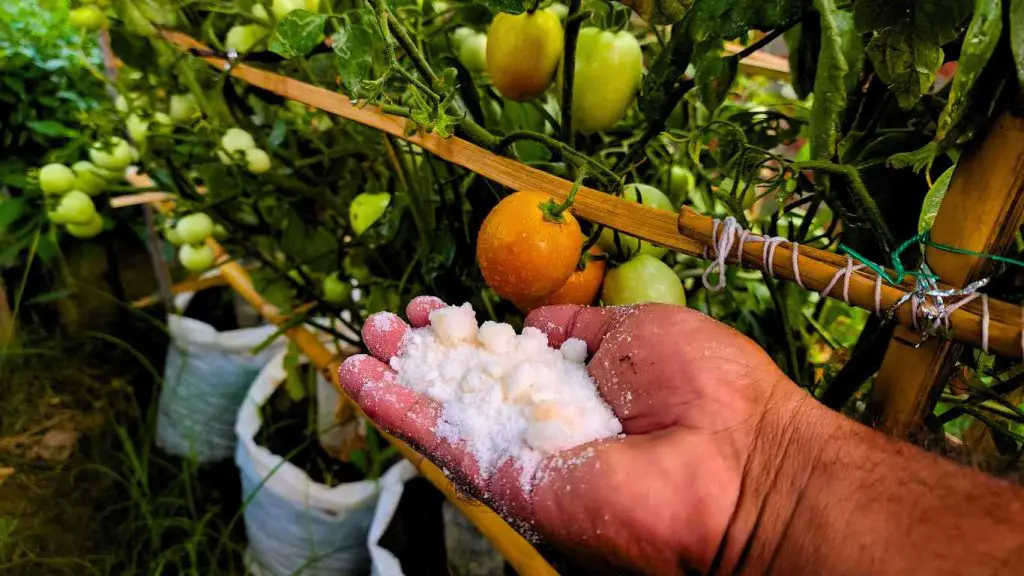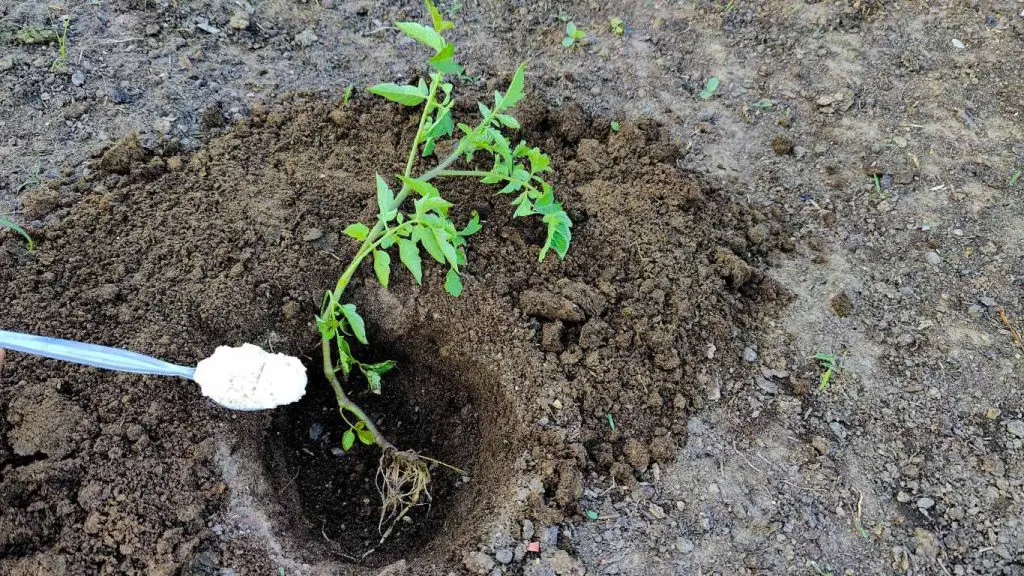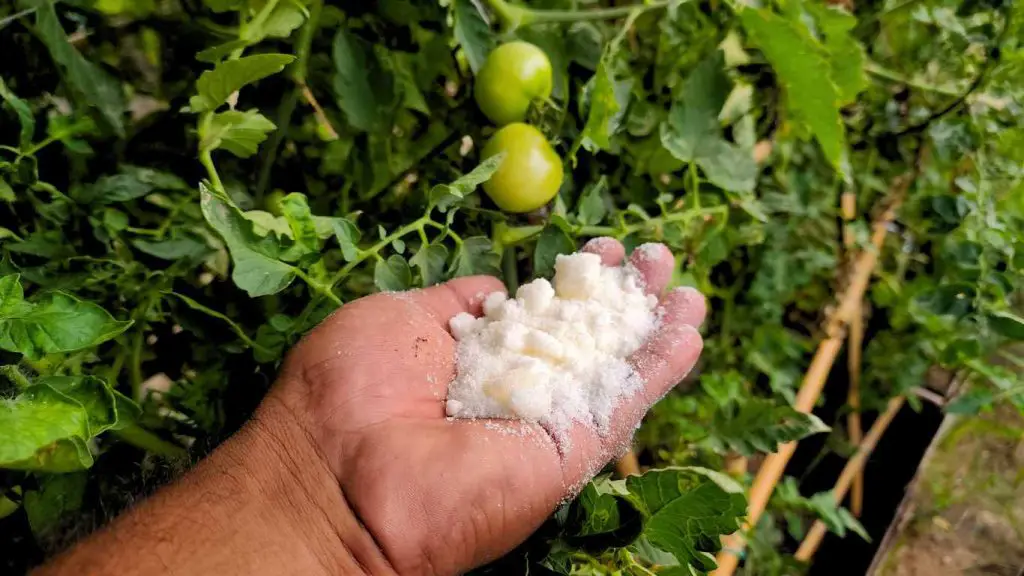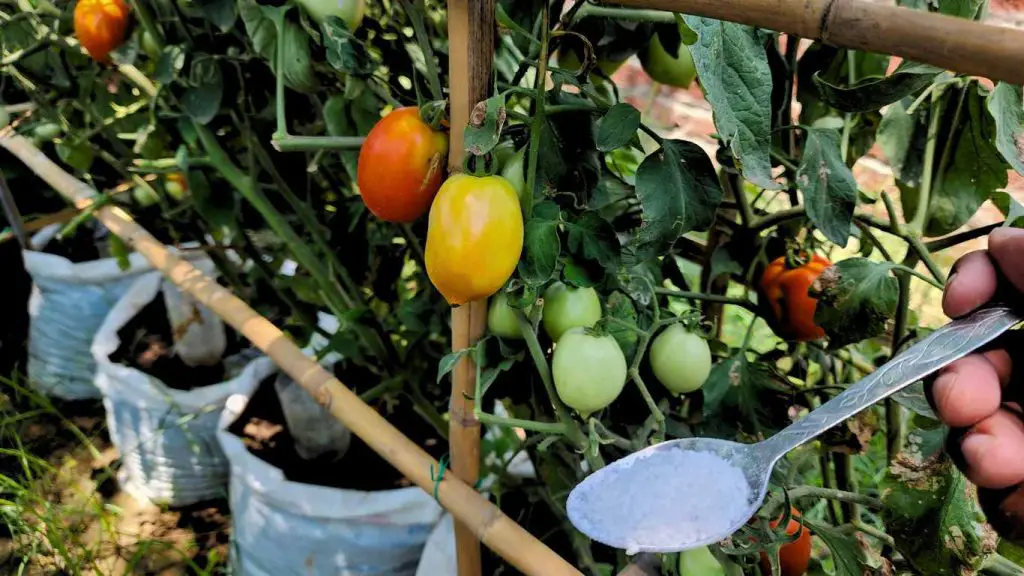Epsom salt, which is also called magnesium sulfate, is a mineral compound that is made up of magnesium, sulfur, and oxygen. It’s used in many areas, like gardening, health, and beauty. Magnesium is important for plant growth and photosynthesis, and sulfur helps make amino acids, proteins, and enzymes.

Benefits of Using Epsom Salt for Plants
Epsom salt is a mineral that plants naturally make. It helps photosynthesis, makes flowers and fruits grow better, and keeps fruiting plants from getting blossom-end rot. As an added bonus, its high magnesium content helps the body absorb calcium and lowers the risk of blossom-end rot
Epsom salt turns on enzymes that help plants absorb nutrients like nitrogen and phosphorus. It also helps plants that don’t have enough magnesium.
Using Epsom salt on a regular basis can keep the magnesium levels in the soil stable, which can stop deficiency symptoms and help plants grow strong. In general, Epsom salt is good for keeping plants healthy and helping them grow.
Epsom salt improves photosynthesis by giving plants enough magnesium, which is an important part of chlorophyll. This makes plants healthier and greener.
Epsom salt increases flowering and fruit production by giving plants important nutrients like magnesium. This leads to more flowering and fruit set, which increases tomato yields.
Epsom salt can help plants absorb nutrients better, which indirectly helps them absorb calcium. However, direct calcium supplementation is usually needed to treat blossom-end rot, which is mostly caused by a lack of calcium.
Epsom salt improves the soil’s nutrient profile, which helps plants take in nutrients like nitrogen and magnesium in a balanced way. This helps tomato plants grow at their best.
When Should Epsom Salt Be Used On Tomato Plants?

During Planting: Epsom salt can be used to get the soil ready for planting tomatoes. It gives young plants magnesium and sulfur, which they need. This early boost helps build strong root systems and encourages healthy early growth.
To use, either mix 1 to 2 tablespoons of Epsom salt into the planting hole or mix it in with the soil.
Throughout the Growing Season: Adding Epsom salt to tomato plants on a regular basis during the growing season can help them grow and make more fruit. Adding Epsom salt to the soil, spraying it on the leaves, or watering the plants every 4 to 6 weeks helps keep the magnesium levels in the soil at a good level.
Start applying after the plants have been established and keep doing so until the end of the growing season. Change how often you apply depending on the health of the plants and the condition of the soil.
When There Are Signs of Magnesium Deficiency: Tomato plants that don’t get enough magnesium will have leaves that turn yellow with green veins, grow slowly, and not make many fruits. Epsom salt can be used right away to fix this problem. It can be sprayed on the leaves or mixed into the soil.
Mix one tablespoon of Epsom salt with water and put it on the leaves for a quick fix. For soil, sprinkle one to two tablespoons around the base of the plant and give it lots of water. Do it again and again until your symptoms get better.
By monitoring and applying Epsom salt to tomato plants on a regular basis, you can avoid deficiencies, encourage healthy growth, and make sure they work at their best by giving them the nutrients they need.
Keep Reading:
- More Best Ways To Use Epsom Salt In The Garden
- How To Grow Cherry Tomatoes From Slices
- How To Grow Beefsteak Tomatoes In Pots
- Never Plant Tomatoes Without This. Read This For Large Fruits And More Tomatoes
How to Use Epsom Salt on Tomato Plants?

1: Soil Application
Before you plant tomato seedlings, you should test the soil to see what nutrients are already there, what the pH level is, and whether you need to add more magnesium.
Based on what you find, add one to two tablespoons of Epsom salt to each planting hole. Put the salt into the holes for the plants and mix it well with the soil around them. For bigger garden beds, use 1 cup of salt for every 100 square feet of soil.
Spread the salt out evenly. Mix the salt into the top 6 to 8 inches of soil with a garden fork or tiller. Put the seedlings in the holes and fill them with soil, making sure the plants have good contact with the soil that has Epsom salts added to it. To get rid of the Epsom salt and make nutrients available, give the seedlings a lot of water.
Adding Epsom salt to the top of established tomato plants during the growing season is very important for keeping the nutrient levels stable and helping the plants grow and produce fruit.
Top-dressing can quickly fix plants that show signs of magnesium deficiency, like leaves turning yellow with green veins.
Spread out 1 tablespoon of Epsom salt around the base of each plant, one tablespoon for every foot of plant height. Use a garden fork or your hands to gently work the salt into the top inch of soil. This will make it easier for the roots to get.
After putting the salt on the plants, give them a lot of water to break it up and get nutrients to the roots. During the growing season, use Epsom salt every 4 to 6 weeks to keep the magnesium levels in the soil stable.
Keep an eye on the plant’s overall health and think about increasing how often you top-dress them if signs of deficiency show up again.
2: Foliar Spray
For this recipe to work, you need Epsom salt and water. One tablespoon of salt should be mixed with one gallon of water to make the solution.
Liquid soap and other optional additions can help the solution stick to the leaves better. Put the ready solution into a spray bottle or garden sprayer, and make sure the nozzle makes an even mist.
To keep plants’ magnesium levels at a healthy level, use the foliar spray every two to four weeks. If signs of magnesium deficiency show up, use the spray once a week until the signs go away. This helps keep magnesium levels at a good level during the growing season.
Spray the plant with foliar spray early in the morning or late in the afternoon to help the plant absorb it better and lower the risk of leaf burn.
Spraying shouldn’t be done when it’s very hot outside, because the direct sunlight can dry out the solution and burn the leaves. It is best to use the spray on a calm, dry day so that it doesn’t get washed off by rain or wind.
Cover both the upper and lower leaf surfaces completely to make sure magnesium is absorbed. Use a gentle mist setting and hold the spray nozzle 12 to 18 inches away from the plant to protect the leaves.
Spraying tomato plants’ leaves with Epsom salt is an effective way to get magnesium to them, which will improve their health and productivity as a whole.
3: Watering with Epsom Salt
A watering can or garden hose with a mixing attachment can be used to mix Epsom salt with water. 1-2 tablespoons of Epsom salt should be mixed with 1 gallon of water and stirred well until the salt is completely dissolved.
If your garden is bigger, change the ratio. For the best results, you need to prepare it ahead of time because storing it for a long time can cause the salt to settle.
It is important to use Epsom salt solution to help tomato seedlings grow strong roots so that the plants stay healthy and produce lots of tomatoes. To keep magnesium levels at a good level, plants should be watered every three to four weeks during the growing season.
Early in the morning or late in the afternoon is the best time to water so that the soil can soak up the water without it evaporating too quickly. If you don’t want to lose water or stress your plants, don’t water during the hottest parts of the day.
Focusing on the base of the plant, watering slowly and evenly, and deep watering to reach the lower root zone are all ways to water plants that help roots grow deeper and get nutrients more easily.
It is very important for tomato plants to have consistently moist soil to avoid stress and encourage healthy growth.
Putting mulch around the base can also help keep the soil moist, keep the temperature stable, and make it harder for weeds to grow. Using Epsom salt on tomato plants on a regular basis and in the right way will help keep them healthy and productive.
Precautions and Tips

Epsom salt is a powerful fertilizer that can improve the health and yield of tomato plants by giving them nutrients like sulfur and magnesium. But too much use can throw the soil out of balance.
To keep from using too much, stick to the suggested amounts and times for application. Also, keep an eye on how the plant reacts and change the rate if necessary. Before you add Epsom salt, you should test the soil to see what nutrients are already there.
It is possible to mix Epsom salt with other fertilizers, but it is important to know what nutrients tomato plants need. It is suggested to use a balanced amount of Epsom salt and a full fertilizer that includes nitrogen, phosphorus, potassium, and micronutrients.
To keep nutrients from reacting with each other, use Epsom salt separately from nitrogen-based fertilizers. Apply during active growth periods, avoid extreme weather or stress, and give plants a lot of water after applying.
Foliar sprays help plants absorb nutrients quickly. Fertilization methods can be changed by keeping an eye on plant health and soil conditions on a regular basis.
Epsom salt, which is a type of magnesium sulfate, is very good for tomato plants. It helps plants absorb important nutrients like nitrogen, phosphorus, and sulfur, improves photosynthesis, and leads to healthier blooms and fruit sets.
It also indirectly stops blossom-end rot, which is caused by an imbalance of nutrients and is mostly caused by a lack of calcium. To get the most out of Epsom salt, keep a close eye on your plants for signs of magnesium deficiency or poor fruit set.
If the magnesium in your soil is low, adding Epsom salt in the right amounts can fix the problem and make plants do better. But it’s important to use Epsom salts in moderation with other plant care tasks, like watering, feeding the soil, and getting rid of pests.
You can improve your tomato plants’ health and yield by keeping an eye on how they react to treatments and making changes as needed.
